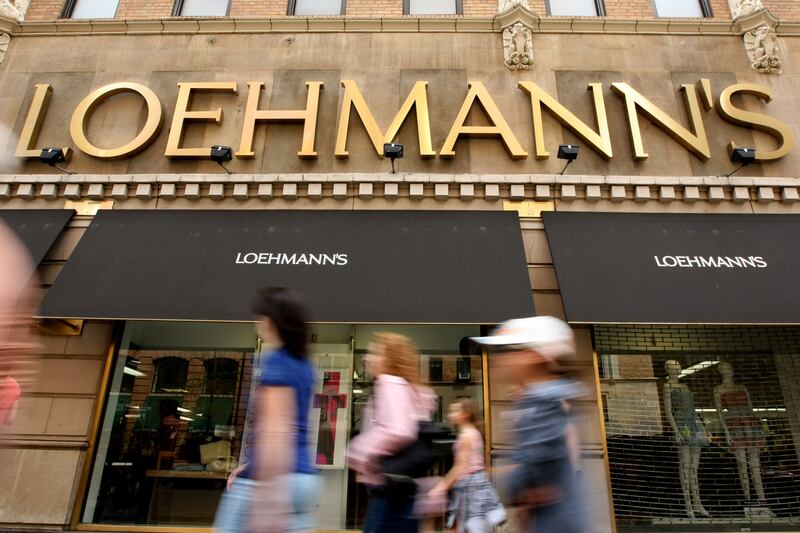
This week marks the death of one of the greatest names in American fashion. Despite enjoying a long, grand life of 93 years, many friends, family, and fans are still taking the loss very hard.
I’m not referring to the demise of a person, but an institution. Loehmann’s, the luxury discount mecca founded by Frieda Loehmann in Brooklyn nearly a century ago, will be closing its doors for the last time this Wednesday. It had been on the brink of closure before, having filed for bankruptcy protection multiple times. Apparently, the third time proved to be the unfortunate charm.
“It’s sad,” said Kathy, a longtime Loehmann’s shopper. “It’s just a shame after all these years,” she told The Daily Beast while shopping at Loehmann’s for the last time. As a Loehmann’s loyalist, Kathy is in esteemed company. Hollywood legend Lauren Bacall name-checked the store multiple times in her autobiography, while Katie Couric remained a devoted shopper even after her multi-million dollar contracts no longer made bargain hunting a necessity. Former First Lady Betty Ford was also a devoted customer. But, as Time magazine wrote in a 1983 profile of the store during the height of its success, Loehmann’s never really had customers. It had “addicts.”
I should know. I’m one of them. The milestones Loehmann’s dressed me for are too numerous to recall. My first business suit, my first cocktail dress, my very first purchase by a major label (a silk Dolce & Gabbana suit for a special event), and the dress I wore for my first book party (a red Calvin Klein number), all came courtesy of Loehmann’s.
So what went wrong? Did the addicts find other ways to get their fix?
Everyone has a theory about what ultimately brought about the demise of Loehmann’s and other stores like it. Filene’s Basement and Daffy’s, two stores that similarly specialized in providing access to high-end designers at mid-level prices, closed their doors in 2011 and 2012, respectively.
The most widely suspected culprit tends to be online shopping, but that theory doesn’t tell the whole story. After all, other stores have prospered in the cyberspace age, including discount retailers like T.J. Maxx and Marshall’s.
So what gives?
Nikki Baird, a retail industry analyst and Managing Partner at Retail Systems Research, speculated that flash sales were a big part of Loehmann’s undoing. “Flash sales have disrupted the close-out market, and they appear poised for even more growth,” she wrote in an email. “The sense of urgency combined with a much more pleasant shopping experience, and some sites offering a narrative around the products they select, make it hard to compare pawing through racks and bins.” To her point, sites like Gilt will notify members that there will be a sale of merchandise by a specific label during a specific time frame. So, instead of heading to an outlet like Loehmann’s and spending a couple of hours digging around hoping for the best, one can sit at a laptop and spend a few minutes to find a dream dress by a particular label.
Similarly, pop-up shops also gained popularity in recent years, at least in major urban markets like New York. So you might be able to spend an afternoon shopping at a one-day sale of merchandise by your favorite designer, instead of crossing your fingers as you search for hours at a large discount store.
But here’s another possible theory to consider, and perhaps the most troubling one of all. Retail is a microcosm of the larger American culture. As our nation becomes increasingly divided by the haves and have-nots, and as the middle class shrinks to the verge of extinction, we are essentially becoming a nation divided into Barney’s shoppers and Wal-Mart shoppers. Loehmann’s, Daffy’s, and Filene’s were stores where a middle-class person could go to live the luxury dream once in a while. She could splurge on a dress for a special occasion, maybe a once-a-year black tie gala, or a special anniversary dinner, a purchase that she may not be able to afford most of the time, but could afford sometimes—but only if she could find it for the right price. But now, few of those places exist. Marshall’s and T.J. Maxx are unlikely to fill the void since they have never specialized in carrying the high-end brands of stores like Loehmann’s, where Oscar de la Renta evening gowns hung alongside less expensive dresses by lesser-known designers.
While sites like Gilt may carry many of the same marquee designers, so far, their bargains have not been comparable. While Loehmann’s merchandise was significantly marked down to begin with, the real benefit for its shoppers came in the form of coupons or additional discounts generated via the store’s loyalty program. So in the end, a dress by a major designer may arrive at Loehmann’s 25 percent below the original retail price, but with additional coupons or markdowns, a shopper may have ended up paying just 50 percent of the original price.
Reinforcing the idea that Loehmann’s demise is emblematic of the disappearance of the reliable middle class is the fact that its flagship New York store space will soon be occupied by Barney’s New York. (According to reports, Barney’s was housed there many years ago before Loehmann’s opened in the space.)
“Besides Daffy’s, it was the only place I shopped,” Suzanne, a Loehmann’s shopper, said as she waited in the check out line for the very last time. “It’s the end of an era.”





